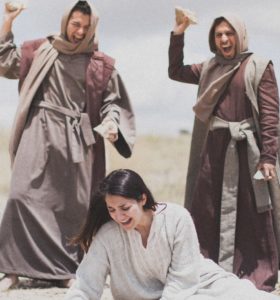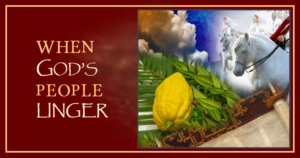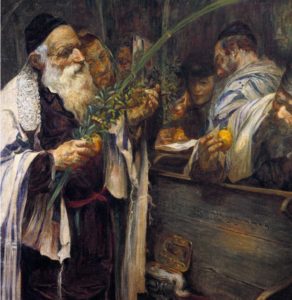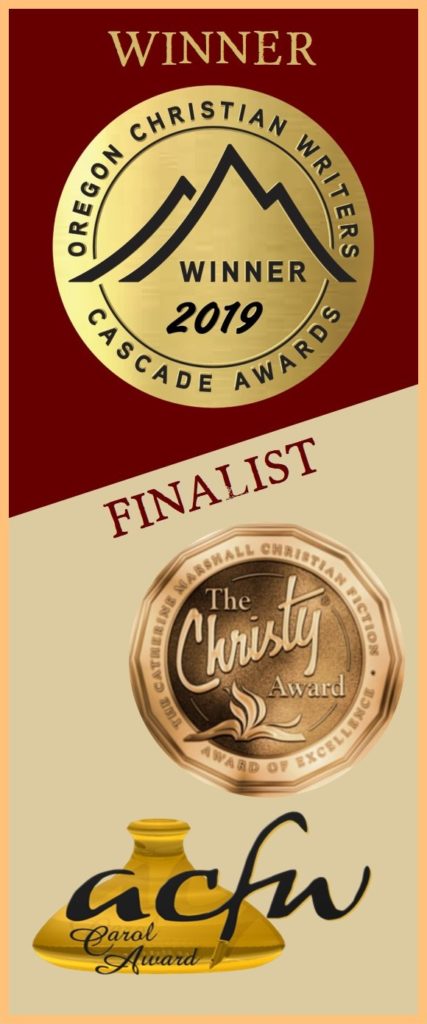When God’s People Linger
The seven-day Feast of Booths (“Tabernacles”), the last of the Lord’s Feasts, has an odd feature—an eighth day.
The Lord’s invitation to linger… with Him.
This is a “bridge” post between my Divine Appointments series, which explores messages the Jewish calendar holds for today’s followers of Messiah, and a series on the “I Ams of Jesus” Lauren Crews and I co-authored. This is a natural transition because many of His “I Am” statements–John records precisely seven of them–have a direct link to the Feasts. Which makes sense, since our Lord came to fulfill the Law (Matt 5:17), and the Feasts are such an integral aspect of the Law.
We’ve recently finished celebrating the last of the Lord’s Feasts, and the most festive. Referred to as simply “the Feast” (John 7:2), or “The Season of Our Joy,” the Feast of Booths (Tabernacles) is to celebrate and remember the Lord’s sheltering presence in the desert–and His abundant blessings in the land (Lev 23:40-44). The key requirement is to “live in booths” for seven days.
On exactly the fifteenth day of the seventh month, when you have gathered in the crops of the land, you shall celebrate the feast of the Lord for seven days, with a rest on the first day and a rest on the eighth day (שמיני עצרת–shemini atzeret).… You shall live in booths for seven days;… so that your generations may know that I had the sons of Israel live in booths when I brought them out from the land of Egypt. I am the Lord your God. (Lev 23:39-43)
And Then There’s This Eighth Day…
So… it’s a seven-day feast with an eight day. Hmm!
The sages interpreted [the eighth day] to mean that God asks all who made the pilgrimage for [the Feast of Booths] to tarry [linger]… with Him one additional day…. “You may compare it to a king who had a festival for seven days and invited all the nations of the world to the seven days of feasting. When the seven days were over and the guests had gone, he said to his friend (Israel), ‘Let us now have a small meal together, just you and I.’” (Bamidbar Rabbah 21, Sukkah 55b)
What a wonderful invitation. And as it often happens, miraculous revelation unfolds when we linger with God!
“I Am the Light of the World”
Backtracking a little, there was another extraordinary feature of the Great Feast which I didn’t dwell on in my previous post on the Feast–the nightly light shows.
According to the Mishnah, at the Temple “there were four golden menorahs with four golden bowls at the top of each, and four ladders each leading to a bowl. Four strong young cohanim [priests] would climb up with pitchers each holding nine liters of oil which they would pour into the bowls…. There was not a courtyard in Jerusalem that was not lit up by the light of the Beit-HaSho’evah [festivities]. Pious men and men of good deeds would dance around [the menorahs] with lit torches in their hands, singing songs and praises, while the Levites played harps, lyres, cymbals, trumpets and innumerable other musical instruments….” (Sukkah 5:2-4) The Gemara on this passage says the menorahs were 75 feet high (Sukkah 52b).
– David H. Stern, Jewish New Testament Commentary
Click on the image to see the full painting on The Temple Institute’s Facebook Page
We do not imagine our distinguished sages as acrobats and tumblers, but they were often agile physically as well as mentally: Rabbi Simon ben Gamaliel [NOTE: The son of Gamaliel 1, under whom Paul studied (Acts 5:34, Acts 22:3)] juggled eight lighted torches and raised himself into a handstand on two fingers, a gymnastic feat no one else could master. Others juggled eight knives, eight glasses of wine, or eight eggs before leaders and dignitaries.
– The Water-Drawing Festival, myjewishlearning.com
It was on the morning of the Shemini Atzeret (eighth day), the morning after the Great Day of the Feast with its final dramatic light show, that:
…He [Yeshua] came again into the temple, and all the people were coming to Him; and He sat down and began to teach them. The scribes and the Pharisees brought a woman caught in adultery, and having set her in the center of the court, they said to Him, “Teacher, this woman has been caught in adultery, in the very act. Now in the Law Moses commanded us to stone such women; what then do You say?” They were saying this, testing Him, so that they might have grounds for accusing Him. But Jesus stooped down and with His finger wrote on the ground. But when they persisted in asking Him, He straightened up, and said to them, “He who is without sin among you, let him be the first to throw a stone at her.” Again He stooped down and wrote on the ground. When they heard it, they began to go out one by one, beginning with the older ones, and He was left alone, and the woman, where she was, in the center of the court. (John 8:2-9)

Surely one of the most intriguing aspects of this wonderful incident is the reaction of the self-righteous zealots who were ready to stone this woman. (Who apparently perpetrated her crime… alone. Oh, wait…)
But if you’ve been following through these Fall Feasts, their reaction becomes a little less surprising. Haven’t we just completed the Forty Days of Repentance and the ten Days of Awe? We’ve just spent forty days examining the state of our souls, humbling ourselves on account of our sins and begging the Living God to treat us with mercy. No wonder Yeshua’s words cut to the quick.
Immediately after this,
Jesus again spoke to them, saying, “I am the Light of the world; he who follows Me will not walk in the darkness, but will have the Light of life.” John 8:12
The Great I Am Revealed on This Eighth Day
This statement set off a lengthy verbal sparring session with the Pharisees, occasioning three of Jesus’ boldest claims in Scripture:
Unless you believe that I am, you will die in your sins. (John 8:24)
When you lift up the Son of Man, then you will know that I am. (John 8:28)
Before Abraham was born, I am. (John 8:58)
(Many translations read “I am He” in these verses, but the He should be in italics to show it’s not in the Greek text.)
When Yeshua applied the label “I am” to Himself, it was a reference to God’s most sacred name.
The most important of God’s Names is the four-letter Name represented by the Hebrew letters Yod-Hei-Vav-Hei (YHVH). It is often referred to as the Ineffable Name, the Unutterable Name or the Distinctive Name. Linguistically, it is related to the Hebrew root Hei-Yod-Hei (to be), and reflects the fact that God’s existence is eternal.
– Judaism 101: The Name of God
The Pharisees didn’t miss His meaning.
Therefore they picked up stones to throw at Him. (John 8:59)
The Mishnah is interesting here. According to Sanhedrin 7:5, “The blasphemer – [he] is not liable until he [explicitly] utters the name [of God].”
So when the Jews picked up stones, it was because they understood His “I am” as an utterance of the Name of God.
Why Believe Him?
As Jesus left the temple after this discussion, He encountered the man born blind. He reiterated the claim he had made the day before, “I am the Light of the World” (John 9:5), then applied a mud-and-spit mask to the man’s eyes. Jesus sent him to wash at the Pool of Siloam, specifically—the very pool from which the priests drew water for their elaborate ritual the night before. The man “went away and washed, and came back seeing” (John 9:7).
Yeshua demonstrated the truth of His claims by using the WATER of the same sacred pool to give LIGHT to the eyes of a man born blind!
“Since the beginning of time it has never been heard that anyone opened the eyes of a person born blind.” (John 9:32)
And here’s another radical claim Jesus made that day.
Truly, truly, I say to you, if anyone keeps My word he will never see death. (John 8:51)
These people had just spent seven days observing every minute detail Moses captured about Sukkot. Down to what they were supposed to carry.
Sukkot in the Synagogue. Leopold Pilichowski (1869-1933).
Via Wikimedia.
And many more traditions the rabbis had come up with outside of Scripture.
Has their elaborate Sukkot ritual saved anyone from death? No.
Has it given anyone back his sight? No.
No wonder the Pharisees were torqued at Jesus. And afraid. And no wonder “the Jews had already agreed that if anyone confessed Him to be Christ, he was to be put out of the synagogue.” (John 9:22)
If you haven’t read my post on Sukkot, you’ll find the conclusion of this story there. Hint: it takes us right to Palm Sunday!
So, the eighth day of tarrying produced some extraordinary revelation.
Good Things Come to Those Who Linger
This idea of accepting God’s invitation to linger reminds me of a story in Exodus. Before the Sin of the Golden Calf, the Lord would “go before [Israel] in a pillar of cloud by day… and in a pillar of fire by night” (Ex 13:21). But after the Calf disaster, the Lord would no longer proceed with them as before. Instead, the pillar of cloud would descend to a special “tent of meeting” Moses built—significantly, “outside the camp, a good distance from the camp.” (Ex 33:7)
Whenever Moses entered the tent, the pillar of cloud would descend and stand at the entrance of the tent; and the Lord would speak with Moses… face to face, just as a man speaks to his friend. When Moses returned to the camp, his servant Joshua, the son of Nun, a young man, would not depart from the tent. (Ex 33:9-11)
Joshua would linger in the place where God’s presence rested. In fact, he wouldn’t leave it!
And thus one of the most powerful leaders in scripture was born.
Moses’ Tent of Meeting was eventually succeeded by the Tabernacle with its elaborate sacrificial system. Israel’s sin had created such a deep rift between them and God that only blood sacrifice could remedy it. The Lord couldn’t “go along in their midst” again until the Tabernacle was constructed and the sacrificial system in place (Ex 33:3).
Yeshua and the New Tabernacle
So what does the Tabernacle look like in the New Covenant, this “new and living way Jesus inaugurated for us through the veil, that is, His flesh” (Heb 10:20)?
And the Word became flesh and dwelt among us, and we saw His glory, glory as of the only begotten from the Father, full of grace and truth…. For the Law was given through Moses; grace and truth were realized through Jesus Christ. No one has seen God at any time; the only begotten God who is in the bosom of the Father, He has explained [or fully declared] Him. (John 1:14,17,18)
The word for “dwelt” is σκηνόω, skēnoō, which is the verb form of σκηνος, skēnos, a tent or tabernacle!
I’m seeing now for the first time how this wonderful passage reflects the Exodus 33-34 story. Moses, God’s special friend, pleaded for a chance to see God’s glory. And in response the Lord proclaimed He “abounds in lovingkindness and truth” (Ex 34:6). And now, like Moses, we behold His glory—in Yeshua, “full of grace and truth.” Further, the Lord gave us the Law through Moses, but “grace and truth” are only realized through Yeshua.
The same word appears both as a noun and a verb in Rev 21:3: “… the tabernacle (σκηνή, skēnē) of God is among men, and He will dwell (σκηνόω, skēnoō) among them…”
The word for “became” in John’s passage is in the middle voice, which makes it reflexive. So the Word was both the acted upon and the actor. Both the entity that became flesh and the Creator that caused it to become.
So according to John 1:14, in Yeshua the Word—the full, intimate and powerful expression of the Godhead; the Great I Am Himself—generated itself into flesh and “tabernacle’d” among us!
Check this out, from Hebrews:
And He [Yeshua] is the radiance of His [God’s] glory and the exact representation of His nature, and upholds all things by the word of His power. (Heb 1:3)
God has inherent glory, but we can only see that glory because it radiates. And the radiance is Christ!
Adding John 1:18 (“No one has seen God at any time”) to Heb 1:3 (Yeshua is “the radiance of God’s glory and the exact representation of His nature”), we come to understand that any physical manifestation Moses and the children of Israel experienced of God was actually Yeshua, whose office in the Godhead is to express the Almighty’s purposes in physical form.
- The Word that created the universe? Yeshua.
- The burning bush? Yeshua.
- Pillar of fire / pillar of cloud? Yeshua.
- Presence that met with Moses face to face in the “tent of meeting”? Yeshua, “full of grace and truth.”
- Shekinah glory that settled on the Tabernacle? Yeshua.
The Burning Bush: Yeshua as the “Angel of the Lord”
And that’s the Word that wrapped itself in a tent of flesh and tabernacle’d among us. Will you accept His invitation to linger?
If you’ve never opened God’s free gift of salvation through Jesus (Rom 3:23, 6:23), please please please be persuaded to do it now! It’s simple. Just tell God from your heart that you admit you’re a sinner that needs a Savior (“For all have sinned and fall short of the glory of God.” Rom 3:23) that you’re done running your own life, and that you’re ready to make Jesus Lord of your life.
If you confess with your mouth Jesus as Lord, and believe in your heart that God has raised Him from the dead, you shall be saved. For with the heart a person believes, resulting in righteousness, and with the mouth he confesses, resulting in salvation. For the Scripture says, “Whoever believes in Him will not be disappointed.” (Rom 10:9-11)
The decision that saves you is that simple!
Simple… But no one said living it out will be easy. Especially now.




No Comments